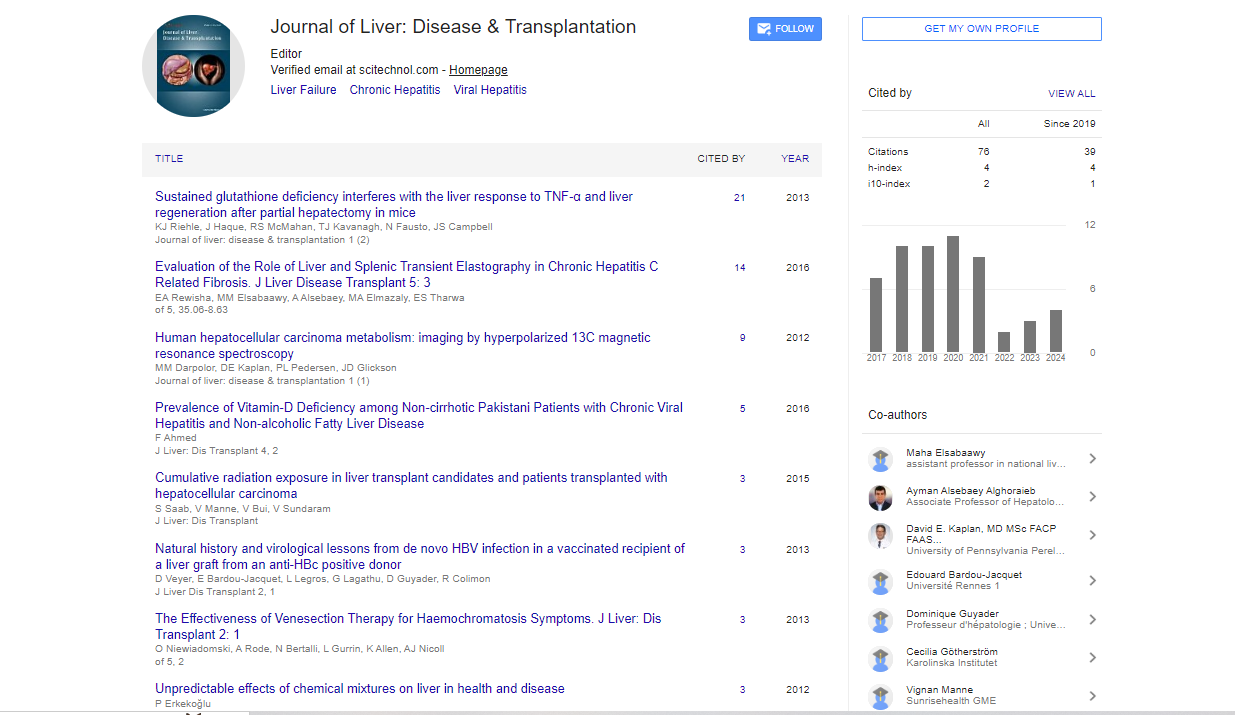Perspective, J Liver Disease Transplant Vol: 13 Issue: 4
Gut-Liver Axis in Alcoholic Liver Disease: Pathophysiological Mechanisms and Therapeutic Targets
Cardillo Aoh*
1Department of Digestive, HBP and Liver Transplantation, Sorbonne University, Paris, France
*Corresponding Author: Cardillo Aoh,
Department of Digestive, HBP and Liver
Transplantation, Sorbonne University, Paris, France
E-mail: aoh.cardi@su.fr
Received date: 28 November, 2024 Manuscript No. JLDT-24-156897;
Editor assigned date: 02 December, 2024, PreQC No. JLDT-24-156897 (PQ);
Reviewed date: 16 December, 2024, QC No. JLDT-24-156897;
Revised date: 23 December, 2024, Manuscript No. JLDT-24-156897 (R);
Published date: 30 December, 2024, DOI: 10.4172/2325-9612.1000288.
Citation: Aoh C (2024) Gut-Liver Axis in Alcoholic Liver Disease: Pathophysiological Mechanisms and Therapeutic Targets. J Liver Disease Transplant 13:4.
Description
Alcoholic Liver Disease (ALD) is a major public health concern, characterized by a spectrum of liver conditions ranging from simple steatosis to severe liver fibrosis, cirrhosis and hepatocellular carcinoma. Recent study has highlighted the essential role of the gutliver axis in the pathophysiology of ALD. The gut-liver axis refers to the bidirectional communication between the gut microbiota, the gut barrier and the liver. This connection is increasingly recognized as a key contributor to the progression of liver disease, especially in conditions like ALD. Disruptions in the gut-liver axis contribute to the pathogenesis of ALD by promoting inflammation, gut barrier dysfunction and systemic endotoxemia. The gut microbiota plays a pivotal role in maintaining gut homeostasis. In ALD, alcohol consumption disrupts the composition and diversity of the gut microbiota. Chronic alcohol intake leads to the overgrowth of harmful bacteria and a decrease in beneficial ones, resulting in an altered gut microbial composition or "dysbiosis." These changes are associated with increased intestinal permeability, allowing for the translocation of bacterial products such as lipopolysaccharides (LPS) from the gut lumen into the bloodstream. LPS is a component of the outer membrane of gram-negative bacteria and acts as a potent endotoxin. Once in circulation, LPS stimulates the liver's immune response by triggering the activation of Toll-Like Receptor 4 (TLR4) on liver cells, leading to the release of pro-inflammatory cytokines such as Tumor Necrosis Factor-Alpha (TNF-α) and Interleukin-6 (IL-6). These cytokines exacerbate inflammation and liver damage, driving the progression of ALD.
The liver plays a central role in metabolizing alcohol and clearing bacterial products from the gut. However, in ALD, alcohol-induced liver injury impairs the liver's detoxification capacity and its ability to clear endotoxins. This further intensifies systemic inflammation and liver damage. The impaired liver function also leads to a reduction in the production of bile acids, which are essential for maintaining gut barrier integrity. Bile acids play a role in maintaining the tight junctions between intestinal epithelial cells. Alcohol consumption disrupts bile acid synthesis, contributing to gut barrier dysfunction, increased intestinal permeability and the translocation of harmful bacterial products into the bloodstream. Systemic inflammation resulting from gut-liver axis dysfunction contributes to the progression of ALD. In addition to promoting the release of pro-inflammatory cytokines, the gut-derived endotoxins also activate immune cells in the liver, such as Kupffer cells, leading to increased production of Reactive Oxygen Species (ROS) and further exacerbation of oxidative stress. Oxidative stress is an important factor in the development of liver fibrosis, cirrhosis and liver cancer in ALD patients. Chronic alcohol consumption amplifies oxidative stress, impairing liver function and promoting fibrogenesis.
Therapeutic strategies targeting the gut-liver axis offer promising avenues for managing ALD. Restoring gut microbiota balance and enhancing gut barrier function may help reduce the impact of dysbiosis and endotoxemia. Probiotics and prebiotics have been proposed as potential therapeutic options. Probiotics are live beneficial bacteria that can restore gut microbial balance, while prebiotics are non-digestible fibers that promote the growth of beneficial bacteria. Clinical studies have shown some assurance in using probiotics to reduce endotoxemia and alleviate inflammation in ALD patients, but further study is needed to confirm their efficacy. Other therapeutic targets include bile acid-modulating agents. Bile acid sequestrants, such as Ursodeoxycholic Acid (UDCA), have been investigated for their potential to restore bile acid metabolism and improve gut barrier function. These agents help reduce intestinal permeability and decrease the translocation of LPS into the bloodstream, thereby reducing systemic inflammation and liver damage.
Conclusion
Further study is required to better understand the complex interactions within the gut-liver axis and to identify more effective therapeutic targets. Future studies should focus on personalized approaches that consider individual differences in gut microbiota composition, host genetic factors and the specific contributions of gutderived endotoxins to liver injury. Such advancements may lead to the development of targeted therapies aimed at restoring gut-liver axis integrity, ultimately improving outcomes for patients with alcoholic liver disease.
 Spanish
Spanish  Chinese
Chinese  Russian
Russian  German
German  French
French  Japanese
Japanese  Portuguese
Portuguese  Hindi
Hindi 